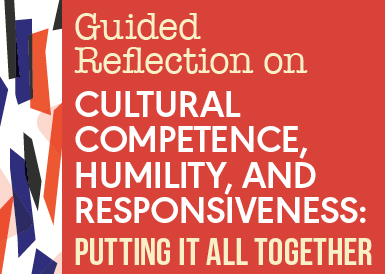Marrying Cultural and Clinical Practices: Adapting Clinical Practices to be Inclusive of Cultural Beliefs
Carmen Ana Ramos-Pizarro
PREBRIEF
Some highly visible cultural and religious practices, such as wearing religious attire (e.g., the Muslim hijab, the Catholic mantilla veil, the Jewish yarmulke/kippah, or the Sikh turban), may physically affect service delivery because of a need to remove or adjust while also having an influence as the result of a conscious or implicit bias (e.g., having negative thoughts or misperceptions about a racial/ethnic group identifiable from their apparel). It is important for clients to feel respected and that their cultural practices and values are accommodated when receiving therapy services. Clinicians can benefit from continued education regarding other cultures and self-reflection practices to help identify conscious bias and implicit bias. This case provides suggestions for strategies that may be implemented in a speech-language pathology or audiology clinic that help to acknowledge and support unique expressions of culture.

About this Module >
This module was taken from a chapter in a book authored by ASHA's Multicultural Issues Board.
To learn more, check out the book Guided Reflection on Cultural Competence, Humility, and Responsiveness: Putting It All Together.
Module Instructions and Objectives
The Case Scenario below is divided into five parts.The Author’s Commentary section provides further information. At the end of the module, be sure to check out the Key Takeaways and learn more about additional resources on these topics.
Answer the Check-In questions throughout this module to stimulate your thinking and reflect on the culturally inclusive strategies you can use. These are open-ended questions that will not be scored.
Describe cultural patterns of some traditional Muslim individuals and how they may impact family dynamics.
Develop recommendations for clinical practices to accommodate cultural/religious practices of Muslim families.
Case Scenario
Part 1

Mrs. Ibrahim, a 33-year-old Muslim woman, came to clinic accompanied by her husband and two children, ages 14 and 8, seeking voice therapy services. The family arrived 45 minutes past the appointment time and were surprised when the receptionist explained they would have to reschedule the evaluation because of a strict policy about arriving on time. Mr. Ibrahim explained they were not used to such strict rules about punctuality and would wait in the lobby until there was an opening. The administrative staff told them this was not possible.
Case Scenario
Part 2

As the family was ready to leave, the staff received a phone call, and because of a last-minute cancellation, Mrs. Ibrahim was able to be seen that afternoon. Mrs. Ibrahim’s husband completed all administrative forms and was the primary interviewee during the intake. He explained that her primary complaint was a complete loss of her voice. When offered an interpreter, Mr. Ibrahim stated that he spoke English fluently and said that his wife knew “enough English to get by.” They shared that the family speaks Punjabi at home.
Case Scenario
Part 3

Mr. Ibrahim explained that their family had relocated to the United States in the last year from Pakistan when he was accepted as a graduate student at a local university. Mr. Ibrahim was concerned because his wife was very healthy until 3 months ago when she developed severe hoarseness and general fatigue. A visit to a physician a few weeks after the onset of her symptoms documented Mrs. Ibrahim’s use of whispered speech, prompting a referral to a speech-language pathologist for a full voice evaluation. Mr. Ibrahim expressed concerns about his wife’s loss of voice affecting her ability to work as an Arabic tutor for university students and her ability to socialize with other Pakistani women in their community. Throughout the interview, when questions were addressed to Mrs. Ibrahim, she gazed toward her husband who would respond for her, and she would nod while looking down. After the initial interview with all family members present, Ms. Carter, the speech-language pathologist, and her male student clinician, Mark, invited Mrs. Ibrahim to accompany them on her own to an examination room.
Part 1
Part 2
Part 3 Check-In
Part 4
Part 5
Case Scenario
Part 4

While in the exam room, a full voice evaluation was completed:
Noninstrumental observations of breathing, posture, and muscle tension were gathered while Mrs. Ibrahim attempted production of sustained vowels at comfortable pitch and loudness, at soft and loud levels, and at low and high pitches. To assess more functional speech, the clinician asked Mrs. Ibrahim to read standard sentences and the Rainbow Passage as well as speak about her voice problem. Mrs. Ibrahim fully cooperated with all requests using a whispered voice.
For the final task of the evaluation, under the supervision of Ms. Carter, Mark politely requested that Mrs. Ibrahim remove her hijab for a manual examination of her neck area. She declined the exam. At that point, Mark explained that the procedure would help the clinicians clarify whether displacement, pressure, and massage of the muscles in the neck area could release any muscle tension that may be contributing to her voice loss. After Mark explained the rationale, Mrs. Ibrahim accepted the explanation and completely removed her hijab.
Part 1
Part 2
Part 3
Part 4 Check-In
Part 5
Case Scenario
Part 5

During the manual examination and trial therapy, Mrs. Ibrahim was able to produce brief, but clear, speech elicited after sustained laryngeal massage. The massage appeared to be effective in reducing some of the extrinsic laryngeal muscle tension that was previously identified and contributed to her aphonia. After the trial, Mr. Ibrahim was asked to join his wife along with Ms. Carter and Mark in the exam room. The results of the evaluation were explained.
The clinicians reported that Mrs. Ibrahim presented with muscle tension dysphonia as originally diagnosed and that manual circumlaryngeal techniques, including laryngeal massage used in trial therapy, were successful in helping Mrs. Ibrahim produce some voicing. Mrs. Ibrahim was invited to demonstrate her progress in phonating to her husband. Mrs. Ibrahim removed her hijab and demonstrated speech production during the laryngeal massage. Mr. Ibrahim asked the clinicians several questions regarding the treatment.
Mr. and Mrs. Ibrahim thanked the team, and they scheduled their next appointment before leaving the clinic. The following week, Mrs. Ibrahim missed her clinic appointment. The clinic conducted a follow-up phone call and were notified by Mr. Ibrahim that his wife would not be returning for treatment. Mr. Ibrahim did not share any reasons for this decision.
Part 1
Part 2
Part 3
Part 4
Part 5 Check-In
Share what you have learned from this scenario:
Select the buttons below to read the author’s commentary about different factors that are influencing this case scenario. Go to the Key Takeaways after you have read all of the commentary.






